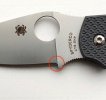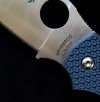I think so.
If you make sure of the angle at each stone, the tip should be sharpened, assuming that you form the apex well from the tip to heel at the coarsest stone.
Also, keep the knife position and angle consistent all the time.
It would affect the sharpening angle at the tip in particular.
For the uneven edge bevel, you have two options.
One, you can sharpen the narrower side more than the other intentionally in future sharpening sessions, and the difference is going to be corrected over time.
Two, you can sharpen at different angles to match the bevel width.
The heel might be difficult.
For Coldsteel, you can probably position the blade in such a way that the ricasso parallels the stone. Then, the stone would not hit there.
Since Spyderco knives do not have a sharpening choil, you cannot sharpen the very end toward the heel.
You should either stop the stone before its hitting the ricasso thereby putting the stone on the bump (see the pic), or remove some materials off first from the heel area using a corner of a coarse stone.
It needs some patience, and the result won't look very nice because you may need to remove some materials from ricasso as well.
Before

After












